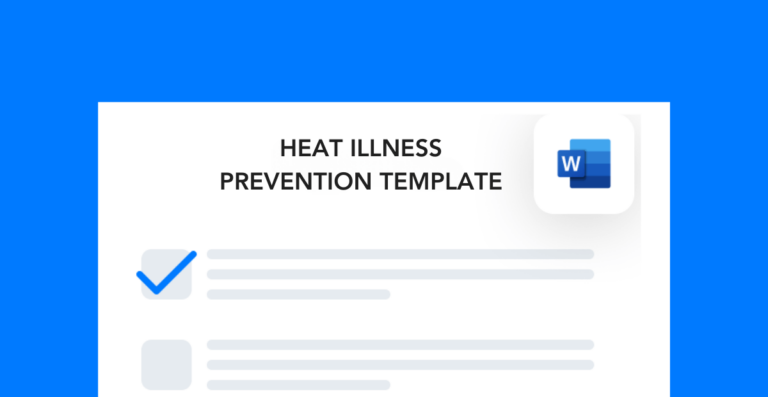During the warm season, heat stress poses a major health risk for employees in industries ranging from construction to hospitality. Therefore, one of the most effective ways to protect your workers from heat-related hazards is to encourage personal safety. Use the following talking points to deliver a clear and practical heat stress toolbox talk.
Free template!
Download this free heat illness prevention template to create your site’s safety plan for heat-related health incidents.
Heat stress toolbox talk overview
In this toolbox talk, we’re going to answer three main questions:
- What exactly is heat stress?
- What are the signs and symptoms of heat stress?
- How can you prevent heat stress?
Basically, once you know what to look out for, you can better protect yourself against heat illness.
Heat stress definition
Heat stress occurs when the body cannot release excess heat. As a result, the heart rate rises and the body struggles to function properly. Heat exhaustion, heat rash, heat stroke, and heat cramps represent the primary types of heat stress illnesses.
Moreover, several variables often contribute to heat stress. High temperatures or humidity, lack of proper hydration, and strenuous physical activity create the most common risks.While heat stress occurs most often during the summer months, it just takes one unusually hot day in the spring or fall to put you at risk.
Signs and symptoms
To protect yourself from heat stress, you need to know the symptoms. The earlier you can recognize the signs, the less likely you are to develop serious complications like strokes or seizures. Depending on what type of heat illness you develop, possible side effects include:
- Nausea and vomiting
- Fainting
- Muscle spasms
- Dizziness or lack of mental clarity
- Headache
- Seizures
- Thirst
- Red, irritated bumps
- Excessive sweating
If you begin to feel any of these symptoms, it’s important to let your supervisor know so they can help you cool down and stay safe.
Heat stress prevention strategies toolbox talk
Fortunately, you can take many steps to stay safe in the heat. Above all, the best step is to come to work prepared for hot weather.
In particular, you can prepare by:
- Dressing in light, loose layers
- Packing extra food and water
- Drinking water throughout your shift
- Resting in between difficult tasks
- Wearing hats, sunscreen, and other protective gear
It’s also important to look out for your teammates in the heat. While working, it’s easy to get distracted and miss the signs of heat stress. Help each other out by staggering your breaks (when possible) and keeping a close eye on everyone’s health.




